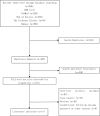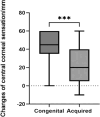Systematic analysis of factors affecting the efficacy of corneal reinnervation surgery in treating neurotrophic keratitis
- PMID: 40796880
- PMCID: PMC12345085
- DOI: 10.1186/s40001-025-02992-8
Systematic analysis of factors affecting the efficacy of corneal reinnervation surgery in treating neurotrophic keratitis
Abstract
Objective: This study investigated the efficacy of corneal neurotization (CN) surgery for treating neurotrophic keratitis (NK) and evaluated potential factors affecting treatment outcomes.
Methods: Literature databases were searched from the inception to January 2024 for retrospective or prospective studies related to corneal neurotization for NK treatment. Data analysis was performed using SPSS 26.0, including analysis of variance, rank sum tests, and multiple regression analysis to determine the efficacy of CN and the impact of patients' age, gender, surgical method, and etiology on surgical outcomes.
Results: A total of 14 retrospective or prospective studies were included, comprising 191 patients who underwent CN for neurotrophic corneal lesions. CN significantly improved Mackie staging, logMAR visual acuity, and corneal sensation in patients with congenital and acquired NK (p < 0.0001). In young patients (≤ 30 years), improvement in central corneal sensation was more pronounced (p < 0.05), while elder patients (> 30 years) showed more significant visual acuity improvement (p < 0.05). Multiple linear regression analysis also showed that age was associated with the postoperative improvement in logMAR visual acuity: the elder the patients, the more improvement in visual acuity (p < 0.05). Compared to direct corneal neurotization (DCN), indirect corneal neurotization (ICN) showed more significant improvement in central corneal sensation (p < 0.01). And the patients with congenital NK got more improvement of central corneal sensation after CN by comparison with the others with acquired etiologies (p < 0.001). Multiple linear regression analysis suggested that congenital etiology was associated with more significant postoperative improvement in corneal sensation (p < 0.05).
Conclusion: CN surgery significantly improves visual acuity, NK Mackie staging, and corneal sensation in NK patients. Age, etiology, and surgical technique may significantly influence treatment outcomes.
Keywords: Corneal nerve transplantation; Corneal neurotization; Corneal sensation; Neurotrophic keratitis.
© 2025. The Author(s).
Conflict of interest statement
Declarations. Ethics approval and consent to participate: Not applicable. Consent for publication: Not applicable. Competing interests: The authors declare no competing interests.
Figures







Similar articles
-
Indirect Corneal Neurotization: Long-Term Outcomes Using a Sural Nerve Graft in Patients With Facial Palsy and Neurotrophic Keratopathy.Cornea. 2025 Aug 20. doi: 10.1097/ICO.0000000000003969. Online ahead of print. Cornea. 2025. PMID: 40833019
-
Corneal Neurotization Using the Supratrochlear Nerve With a Great Auricular Nerve Graft for Neurotrophic Keratopathy: Long-Term Results.Am J Ophthalmol. 2025 Jun 23;278:176-190. doi: 10.1016/j.ajo.2025.06.014. Online ahead of print. Am J Ophthalmol. 2025. PMID: 40562087
-
Corneal neurotization meets COVID-19: a case report of minimally invasive corneal neurotization complicated by COVID-19-related keratitis.J Ophthalmic Inflamm Infect. 2025 Aug 9;15(1):60. doi: 10.1186/s12348-025-00521-6. J Ophthalmic Inflamm Infect. 2025. PMID: 40783656 Free PMC article.
-
Patching for corneal abrasion.Cochrane Database Syst Rev. 2016 Jul 26;7(7):CD004764. doi: 10.1002/14651858.CD004764.pub3. Cochrane Database Syst Rev. 2016. PMID: 27457359 Free PMC article.
-
Endothelial keratoplasty versus penetrating keratoplasty for Fuchs endothelial dystrophy.Cochrane Database Syst Rev. 2014 Feb 14;2014(2):CD008420. doi: 10.1002/14651858.CD008420.pub3. Cochrane Database Syst Rev. 2014. PMID: 24526345 Free PMC article.
References
-
- Ruiz-Lozano RE, Hernandez-Camarena JC, Loya-Garcia D, Merayo-Lloves J, Rodriguez-Garcia A. The molecular basis of neurotrophic keratopathy: diagnostic and therapeutic implications. A review. Ocul Surf. 2021;19:224–40. - PubMed
-
- Schimmelpfennig B, Beuerman R. A technique for controlled sensory denervation of the rabbit cornea. Graefes Arch Clin Exp Ophthalmol Albrecht Von Graefes Arch Klin Exp Ophthalmol. 1982;218(6):287–93. - PubMed
-
- Al-Aqaba MA, Dhillon VK, Mohammed I, Said DG, Dua HS. Corneal nerves in health and disease. Prog Retin Eye Res. 2019;73: 100762. - PubMed
-
- Peterson DC, Hamel RN. Corneal Reflex. In: StatPearls. Treasure Island (FL): StatPearls Publishing; July 25, 2023. - PubMed
Publication types
LinkOut - more resources
Full Text Sources
Miscellaneous

